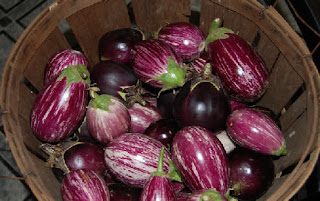We’ve had the chance to get an assortment of root vegetables
over the last few pickups of the 2013 season—beets, turnips, radishes, carrots,
and some potatoes and onions there at the end. Root vegetables are delicious,
nutritious, and very versatile. In fact, you may not realize how versatile they
are, so here are some ideas.
Roast your beets and then dice them and freeze them to add
to salads at the holidays. Such pretty color, and they are tasty, too. Scrub ’em,
put them in a baking pan with a little water (about a quarter cup), cover with
foil, and roast for 45 minutes. Then let them cool, peel them, and dice or
slice them. Freeze them in small amounts in freezer bags.
Use turnips and potatoes along with some greens to make
colcannon or champ. I made a delicious batch of this Irish specialty on
Halloween—or Samhain—the traditional day to eat colcannon for luck (it was the
old Druid new year’s celebration). Peel the potatoes and turnips and cut into
quarters; put them in a pot of water and bring to a boil, then boil until
tender, about 20 minutes. Meanwhile, clean and devein some greens—chard,
spinach, kale, cabbage, whatever you have—and chop into small pieces. You can throw
the greens in with the potatoes and turnips for the last 10 minutes or so, then
drain everything well. Add a little milk and a little butter and whip with a
mixer until you have a fluffy light green concoction. Put it in a warm bowl and
make a well in the middle to add more butter. Yummy!
Butter those radishes and eat them raw. It’s an English way
to eat them, and especially if they are hot, the butter tempers the heat a bit.
A great snack!
Make carrot soup. It’s tasty and it just looks like
fall, that lovely orange color. There’s a great recipe for carrot soup in a
previous blog. (And as a root vegetable bonus, the recipe can be adapted to make beet soup, too!
And, one more idea—take some carrots, onions, and turnips,
and maybe some potatoes, too. Peel them and cook them a little; steam the
carrots and turnips, boil the potatoes, sauté the onions. Then put them in
ovenproof bowls, add some cooked chicken, pour on some gravy, and mix up some
bisquick and make a top crust. Voila, a rich and delicious homemade chicken pot
pie just bursting with root vegetable goodness!
What are you doing with your root vegetables?

































